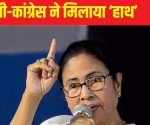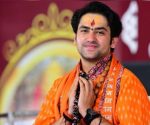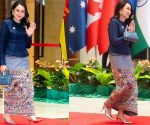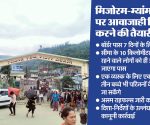Unlikely victory that jolted BJP’s Hindutva push

On May 15, bang in the middle of the Lok Sabha elections campaign, Samajwadi Party chief Akhilesh Yadav stopped for a small rally in Mavai village. The meeting didn’t make too many headlines; the seat of Faizabad, under which Mavai falls, was considered an assured victory for the Bharatiya Janata Party (BJP) because of the frenzy around the inauguration of the Ram Temple in Ayodhya earlier this year. The ruling party had fielded old warhorse and two-time sitting MP, Lallu Singh.
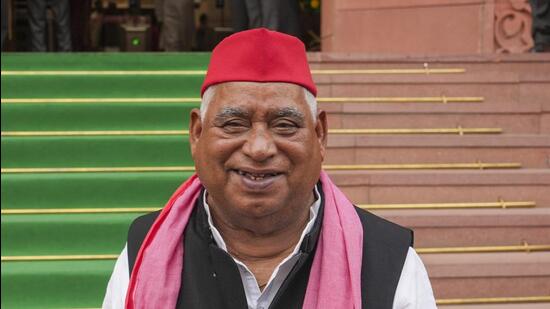
To take him on, Yadav walked up to the dias and introduced his candidate – Awadhesh Prasad. “And here is our former MLA who is contesting the seat…,” he said. Visibly baffled next to him, Prasad attempted to correct him: “No, no. Not former MLA, sitting MLA.”
Yadav swatted him away. “You will soon be the former MLA, as you are becoming an MP.” The crowd cheered, and Prasad smiled. The short clip went viral on social media.
On June 4, the words proved prophetic. Prasad – a nine-time legislator, six-time state minister under three different chief ministers, and a founding member of the SP — registered a comprehensive but shock victory against Singh in a seat that not only encapsulated the BJP’s Hindutva push over the Ram Temple inauguration but also the SP’s resurgence as the single-largest party in UP after being out of power for almost a decade.
And the man who scripted possibly the INDIA bloc’s most consequential electoral win, 78-year-old Prasad, himself represented the crucial shift of the Dalit vote away from the BJP, allowing him to register a rare win for a Scheduled Caste candidate in an unreserved constituency. In his improbable victory by a margin of 50,000 votes was also the triumph of Yadav’s strategy of fielding a Pasi candidate against Singh, prompting non-dominant Dalit communities to back their old leader who got into politics during the turbulence of the Emergency.
“The BJP tried to take the credit for the Ram temple, which was built on the orders of the Supreme Court and tried to derive political mileage to divert people’s attention from serious fundamental problems such as unemployment, poverty, inflation, and issues concerning farmers including the stray cattle menace,” said Prasad. “I was not contesting against BJP, it was the people who were fighting with the BJP.”
Temple and politicsThe Ram Temple has been at the centre of the BJP’s political project for decades. The Ram Janmabhoomi-Babri Masjid dispute planted the seeds for the party’s pan-India revival when it prompted LK Advani to plan an expansive, and eventually violent, Rath Yatra. The party jumped from two parliamentary seats in 1984 to 89 in 1989. Building a Ram Temple at the site Hindus believed was the birthplace of Lord Ram also became part of the Rashtriya Swayamsevak Sangh’s trifecta of ideological goals – the abrogation of Article 370 in Jammu & Kashmir and the implementation of the Uniform Civil Code being the others.
Going into 2024, the BJP was confident about the Faizabad Lok Sabha seat, under which Ayodhya falls. The consecration ceremony of the Ram Temple earlier in January by Prime Minister Narendra Modi had energised the BJP’s base. The party had won four of the five assembly segments that make up the seat in 2022. Lallu Singh had won the seat twice in a row, and the Opposition appeared to have been outmanoeuvred during the temple opening. The party focussed on the infrastructural transformation of Ayodhya – its new avenues, a transformed and renamed airport, a refurbished railway station, and new public spots.
Fighting an uphill battle, SP and Prasad took a different tack. The party focussed on wooing marginalised groups by fielding a Dalit leader on a general constituency seat against the BJP’s Thakur candidate. The campaign consciously stayed away from polarising issues and kept the focus on bread-and-butter issues of livelihood.
“The BJP tried to take the credit for the Ram temple, which is being built on the orders of the Supreme Court, and unsuccessfully tried to derive political mileage to divert attention from serious problems such bas unemployment, poverty, inflation, and issues concerning farmers including the stray cattle menace,” Prasad said.
“Distressed under the BJP rule, we got maximum support from Dalits who were the worst sufferers of the BJP’s policies.” The results showed that the SP had managed to wean up critical Dalit support from the BJP by talking up dangers to the Constitution and everyday worries of income and poverty. Crucial to this endeavour was the appeal of the Pasi leader, whose presence and strong campaign helped shore up support from smaller Dalit communities that had drifted to the BJP since 2014.
“At 78, he walked five to seven kilometres regularly in the morning and then remained in the public till midnight,” said Jai Shankar Pandey, an old associate of Prasad.
To keep the BJP at bay, Prasad called himself a Ram-bhakt, or Ram devotee, at every rally. He even changed his social media bio to “Jai Siyaram”, a greeting that incorporates both Ram and Sita. “I am born in Ayodhya, I am Rambhakt by birth,” he said. “Ayodhya is not anyone’s fiefdom…We are the real Ram-bhakts.”
Humble beginningsBorn in July 1945 to Dukhi Ram and Ram Rati, Prasad’s ancestral house is in Purey Oachchhan Tiwari village of Sohawal tehsil in Ayodhya. “I grew up on the banks of a small river, Madhua. My father was a small farmer and we were seven siblings – an elder brother and five younger sisters,” he said.
His school years were spent in poverty, with no money for even shoes. “When the river was in spate, I used to wade through the water to go to the school. We had a kutcha house with no electricity. So, I studied under a kerosene lamp,” he said. In Class 12, he finally bought an old bicycle for ₹85.
Prasad began his political career at 21, shortly after he took admission in Lucknow University for an LLB degree. “Soon after finishing my LLB, I began practising as a criminal lawyer at Faizabad district court. During my LLB, I developed a lot of political consciousness. In 1974, I quit my law practice and joined politics,” he said.
During the Emergency, Prasad served as the Faizabad district co-convener of the anti-Emergency Sangharsh Samiti. “I was in Faizabad jail and Lucknow jail. While in jail, my mother passed away but I couldn’t get parole to attend her last rites,” he said.
He contested his first assembly elections in 1974 as a candidate from the Bhartiya Kranti Dal – led by former PM Chaudhary Charan Singh — from Sohawal but lost. But in the elections held immediately after the Emergency, he won the seat as Janta Party candidate. By then, he was already seen as an associate of SP patriarch Mulayam Singh Yadav. “I lost my first assembly elections by a narrow margin of 332 votes, but when I won the next elections, my nearest rival’s deposit was forfeited,” he said.
He became a minister of state in the Ram Naresh Yadav government and was given charge of information and general administration portfolios. “Then again, I became a minister in the Banarsi Das government. It was during this time I became very close to Netaji Mulayam Singh Yadav. He was a senior minister in the government.”
The veteran – who served under three chief ministers across parties and won an assembly election nine times – is looking forward to his maiden stint in Parliament. “My ideology is socialism and my focus will be on young people, who are the sona-heera (gold and diamond) of the nation. For them, we’ll stop paper leaks and scrap Agniveer.”












